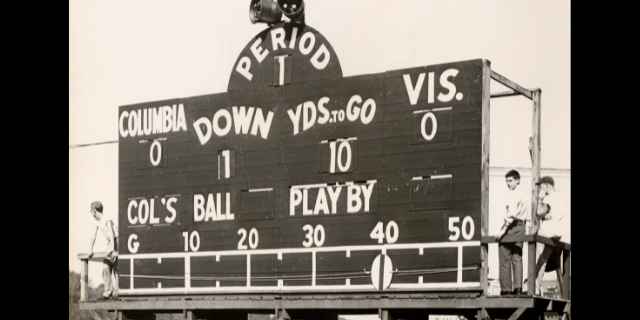American football is different to many sports in that the points for a score depends on how you make the score.
It wasn’t always this way. In the early days, the scoring was exactly like soccer. Goals were the only way to score and each was awarded one point.
So how did it get from that early version to where we are today? This article runs through the history of scoring in football.
How Football Scores Work Today
There are four basic ways to score points in modern American football.
- Touchdown – six points
- Conversion/try – two points or one point
- Field goal – three points
- Safety – two points to the defense
Let’s run through these in turn. Feel free to skip this section if you’re familiar with the modern game.
The Touchdown

A touchdown is scored when the offensive team gets the ball into the end zone while it’s in the possession of a player.
This can be done by the player carrying it (a rushing touchdown) or by catching a pass in the end zone(a touchdown pass).
The end zone starts at the defending team’s goal line and is ten yards deep.
Scoring a touchdown is worth six points and gives the scoring team the right to go for a conversion, also known as a try.
The Conversion/Try
After a touchdown, the scoring team has the right to try for either one or two points.
If they try for two points, the line of scrimmage is set three yards from the defensive goal line. To score the two-point conversion, the offense must get the ball into the end zone exactly like a touchdown.
If the scoring team only goes for one point, the ball is moved to the twenty-five-yard line and the offense must kick the ball between the uprights.
If the defense blocks the kick, picks up the ball, and carries it across the offense’s goal line, the defense scores two points on a return of try.
The Field Goal

To score a field goal, the offense must kick the ball between the upright of the defense’s goal.
The ball may be either held by another player while the placekicker kicks it, or the kicker can dropkick the ball through the uprights.
This means the player drops the ball and kicks it as soon as it hits the ground. The dropkick is almost never seen anymore in football, but it’s still on the rule books.
A field goal is worth three points.
The Safety
The safety occurs in these situations:
- the offense fumbles the ball out of bounds in their end zone
- the ball carrier goes out of bounds in their end zone
- the ball carrier is tackled in their own end zone
In each case, the defense is awarded two points and given possession of the ball.
If the safety happens on a conversion attempt, it’s only worth one point. This is extremely rare, happening only a few times in college and never in the NFL
1869 – One Goal Wins

When the first football game happened in 1869, the only way to score was to kick the ball in the opposing team’s goal.
If you’re interested in the wider history, check out our article on how American football evolved back in these days.
A match was made up of ten games, and a game was complete when one goal was scored.
The team that won the majority of the ten games played was the winner of the match.
1875 – Harvard/Tufts Rules
In 1875, Harvard played two matches against McGill University in Montreal.
One of these Harvard/McGill matches had been played using football rules. The other had been played using the rules of rugby.
That year, Harvard and Tufts played a game under amended rules proposed by Harvard. The Harvard/Tufts rules were a melding of the rules used in these two games.
This was the first time that a team could score a “try”, by grounding the ball in the opposing team’s in-goal area.
This play later evolved into the touchdown and its name still implies grounding the ball, even though that is no longer necessary!
1876 – Things Get Complicated
In 1876 the Intercollegiate Football Association started the football tradition of incredibly complicated scoring rules.
Under these rules, a touchdown counted for one quarter the value of a kicked goal. But more importantly, the touchdown gave the offensive team the right to take a free kick at a field goal.
This is the origin of modern football’s conversion. But in those days the conversion was worth much more than the touchdown.
This was where the dropkick became important. If a player was unobstructed near the goal he might just drop the ball and kick it in. After all, the goal was four times the value of the touchdown!
Here’s an except from the 1876 rules.
“A match shall be decided by a majority of touchdowns. A goal shall be equal to four touchdowns; but in case of a tie a goal kicked from a touchdown shall take precedence over four touchdowns.”
This is a lot more complicated than “one goal wins one game”!
1880s – Walter Camp’s Scoring System
If you read our article on the evolution of American football, you’ll know that Walter Camp was a massive figure in the tale.
From 1876 to 1880, scoring rules were fairly chaotic.
The score was quantified in “goals” or “touchdowns”. Touchdowns were worth various percentages of a goal. And goals were given different weight depending on how, when, and where they were scored.
Enter Walter Camp
In the 1880s Walter Camp settled this down and made it much simpler to understand by codifying scoring and keeping track of the score by points.
This was much simpler than having to remember how and when a point was scored. Think about semi-concussed players trying to do fractional math just to figure out who was winning!
Camp’s initial system was two points for a touchdown, five for a field goal, four for a kicking conversion after touchdown, and one for a safety. He soon altered this to:
- Touchdown – four points
- Field goal – five points
- Kicking a conversion – two points
- Safety – two points
Dropkicks rule!
This rule change made the dropkick even more popular since the conversion after touchdown was worth much less.
If a player thought he could get a touchdown, he would still try to do that. The combination of a touchdown and conversion was worth one more point than the field goal i.e. a combined six points.
However, if he was running free but saw players he thought might catch him before the end zone, he might very well drop the ball and go for the five points right there.
Camp’s point scoring system was so popular that it influenced the adoption of a similar system in rugby union in 1890!
1889 – Moving To Modern Scoring

Still feeling the influence of its soccer roots, Camp’s system made kicking a goal the best way to score the most points. This changed quickly.
It was a fairly universal observation that the touchdown was much more exciting and got a bigger reaction from the crowd than kicked goals did.
Changes were quickly made to reflect this. A few diehard traditionalists may have lamented it, but most fans and players agreed that it was a change for the better!
In 1889 the rule was changed to allow a touchdown by merely entering the end zone, without grounding the ball.
Touchdowns up, goals down!
In 1897 the touchdown became worth five points and in 1912 it was switched to the modern six points.
Over the same period, in 1904 field goals were modified to 4 points, then to the current three in 1909.
The conversion after touchdown was reduced to one point – and given the name “extra point” – in 1898.
By 1912 the modern scoring system was in place, with the exception of the two-point conversion, which was added in 1958.
How The Changes In Scoring Changed The Game

This change in emphasis made a profound impact on how football was played.
In the early days, everything was about setting up to kick a goal. The touchdown was mostly valuable as a setup for a free try at a field goal.
A player would dropkick at the uprights in the middle of a running play if they thought they had an opening because it was worth more points.
This all changed as the touchdown increased in points. A team would never forgo a good chance at a touchdown just to kick a field goal.
End of the dropkick
This, along with changes in the shape of the ball to make it easier to throw, marked the end of the dropkick as a viable tactic.
The New England Patriots are the only NFL team to try the dropkick in over sixty years!
The first time was in 2005 when quarterback Doug Flutie scored three points with a dropkick against the Miami Dolphins in his final professional game.
The second time, Patriots special teams ace Nate Ebner attempted a dropkick in a 2015 game against the Philadelphia Eagles. Of course, Ebner is also United States National Rugby Sevens player.
And he’s a part-owner of a professional rugby franchise. You can read more in our article on who owns the New England Free Jacks.
Flutie’s was the first successful dropkick in the NFL since 1941! It’s safe to say that most fans and opposing players were completely confused and had no idea what they were seeing!
Today, the kicking game continues to decline in importance.
Kicking a field goal is described as “settling” and is often characterized as a victory for the defense!
The two-point conversion is growing in popularity and there is even serious talk of eliminating some parts of the kicking game altogether!
More About Football History
Check out these articles on aspects of football history.
- How the flying wedge began in football and was outlawed
- History of the blitz in football
- History of special teams (scroll to the second half of the article)
- Did American football come from rugby?
And what about the gear? How did equipment develop? Check these articles out: